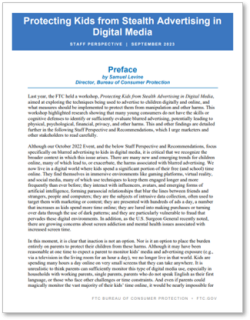Businesses, platforms, social media influencers, and others who advertise or promote products to children online all have a role to play in ensuring that the boundary between advertising and entertainment is clear to children. Based in part on the insights from the 2022 FTC workshop, Protecting Kids from Stealth Advertising in Digital Media, that’s a key component of the 360° approach recommended in a just-published FTC Staff Perspective about protecting kids from blurred advertising.
The Staff Perspective addresses several key questions: What’s the current digital landscape for kids? What is blurred advertising and where do kids encounter it? What does emerging research tell us about kids’ abilities to recognize and evaluate blurred advertising? What are key concerns about blurred advertising?

Participants at the workshop discussed the immersive nature of advertising to kids online, including blurred advertising. It’s everywhere children go, from gaming platforms and “kidfluencer” video channels to social media feeds of kid-friendly characters. Panelists and other experts also confirmed what others have observed: Younger children have yet to develop the skills or cognitive defenses to detect advertising that is blurred with entertainment or educational content.
The potential for harm associated with blurred advertising is significant. You’ll want to read the Staff Perspective for details, but concerns include manipulation by marketers, intrusive data collection, and financial losses due to accidental or emotional purchases. Add those risks to what experts like the U.S. Surgeon General are already telling us about screen addiction and mental health issues associated with increased online time and the potential injury to kids is alarming.
Do parents have an important role to play? Of course. But according to the Staff Perspective, “plac[ing] the burden entirely on parents to protect their children from these harms” ignores the monumental changes to the digital ecosystem that have made a simple “No TV on school nights”-style approach impractical. Keeping a roof over kids’ heads and food on the table is already a challenge – to say nothing of scrutinizing every screen a kid sees throughout the day and staying ahead of every behind-the-scenes digital marketing method that targets children. As the Staff Perspective notes, “[E]ven if parents could magically monitor the vast majority of their kids’ time online, it would be nearly impossible for them to keep up with the ever-changing technology and digital landscape.”
As the Staff Perspective establishes, “In this moment, it is clear that inaction is not an option.” So what’s to be done? The Staff Perspective suggests that only a comprehensive approach can protect children from the harms of blurred advertising – and that any solution should consider these components:
- Don’t blur advertising. There should be a clear separation between kids’ entertainment and educational content and advertising, using formatting techniques and visual and verbal cues to signal to kids that they’re about to see an ad.
- Provide prominent just-in-time disclosures. Disclosures should be provided when the product is introduced and should be conveyed orally and visually to explain the commercial nature and intent of the message. And let’s be clear: Fleeting superimposed text, fine print, and inscrutable legalese won’t suffice. We’re talking about methods designed to change children’s perspectives of what they see.
- Create icons to flag advertising. Stakeholders should work together to create and implement an easy-to-understand and easy-to-see icon to signal to kids that money or free things were provided to the content creator to advertise the product.
- Educate kids, parents, and teachers. Stakeholders should look for ways to educate kids, parents, and educators about how digital advertising works and to help kids recognize and evaluate it wherever it appears. Education could also play an important role in helping promote and support the use of an icon to help kids identify ads.
- Platforms should consider policies, tools, and controls to address blurred advertising. Platforms should consider implementing policies and tools that would require content creators to self-identify content that includes advertising. They also should consider parental controls that allow parents to limit or block their kids from seeing that content.
Of course, the FTC will be monitoring this area and may take law enforcement action when blurred advertising is an unfair or deceptive practice prohibited by the FTC Act.
